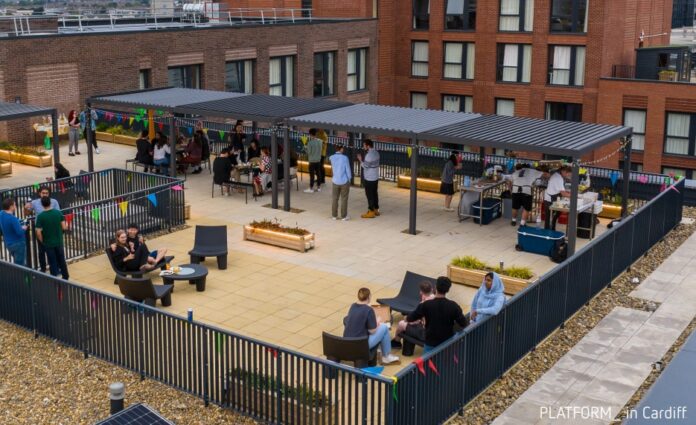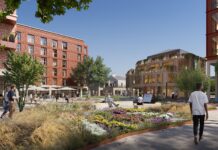How is Build-to-Rent responding to net zero?
In an insightful Q&A with the British Property Federation, Jonathan Rae, our Finance Director and Chair of the Sustainability Steering Group, shared his insights on how PLATFORM_ is leading the charge towards net zero in the Build-to-Rent sector.
How is PLATFORM_ rising to the net zero challenge?
“At PLATFORM_, we recognise that the built environment is one of the largest contributors to climate change and that we,as a developer of new homes and landlord to thousands of residents, have the opportunity and responsibility to create positive environmental and social outcomes for our neighbourhoods. Our role is to nurture those neighbourhoods over the long term.
We are committed to addressing the causes and impacts of climate change within our control and promoting wellbeing for our residents and communities.
To help us deliver on these objectives, we have established our Commitments to Sustainable Living.
These are targets which together represent positive outcomes addressing the impacts of climate change and enhancing the experience of our residents.
These 24 targets cover the three pillars of our approach to nurturing our neighbourhoods:
- Environmental-being environmentally regenerative;
- Social – being people centric; and
- Governance – future proofing our business
Within our environmental pillar, one target is for all our operational assets to be net zero in operation by 2030 and we have signed up to both the BPF Net Zero pledge and the UN Race to Zero to formalise this commitment.
This represents a natural progression for us. Ours was one of the first portfolios in the UK to adopt the BREEAM “In Use” environmental assessment. Now we are moving on to determining net zero pathways for our developments.
These net zero pathways will enable us to identify interventions we can make at our buildings to reduce carbon and assess their cost and benefit. They will also quantify the carbon reductions that will come from decarbonisation of the grid and the amount of residual carbon which may need to be offset.”
What approach are you seeing from investors and lenders when it comes to net zero buildings?
“We see a range of approaches. The greatest focus currently is on the achievement of certain EPC ratings and SAP scores, as these are the key tangible metrics available at the moment. This is also the key metric for lenders providing “green discounts” on development loan margins. Some investors also require us to participate in their reporting for environmental benchmark reporting, such as GRESB.
So far, no investor has required a clear net zero pathway to be determined but our Commitments to Sustainable Living provide comfort that we are preparing ourselves for future developments in investor and lender requirements.”
And are investors moving beyond carbon and looking at the impact of their investments on nature?
“In our experience, investors are currently focused on ensuring that developments are resilient to climate-related risks such as the risk of increased flooding in certain areas, and on ensuring that legal and planning requirements are met. This includes on biodiversity net gain, where we are targeting a 20% uplift across our development portfolio, larger than the new 10% legal requirement.
We are not seeing separate targets relating to the impact on nature beyond that at this stage.”
How important is sustainability to residents?
“From our regular surveys, our residents tell us that their priorities when choosing where to rent are location, security, value for money and the services and amenities of the BtR offer.
From a sustainability perspective, the cost of utilities is the number one priority for residents and so building features which reduce energy consumption are important for our residents – particularly during periods of energy price volatility as we have experienced in the last couple of years.
It might be worth noting that in November, Homeviews released their annual Sustainability Report on how residents value sustainable building features. This found that 70% of residents across rental tenures do value sustainable building features, an increase of 2% from 68% in 2022.
Within that, BtR residents were the biggest advocates with 72% of residents valuing sustainable building features.
This survey reported that the highest priority sustainable building features were access to recycling services, followed by energy saving measures, use of renewable energy sources and then access to green spaces.”
What are the key challenges that you face in the transition to net zero?
“One of the biggest challenges to determining a net zero pathway currently is the lack of a clear, standardised method of determining “net zero”. We’re looking forward to the release of the UK Net Zero Carbon Buildings Standard which we expect to provide a standardised basis for all building developers and operators to align.
Another major challenge is of course cost. Currently lower carbon concrete and higher quality insulation products come with a notably higher cost, reflecting the more intensive manufacturing processes and lower quantities being produced. Over time these costs should come down as adoption improves but the choice to adopt these products has to feed into the overall viability assessment of new developments – which already has many other cost pressures at the moment.
Photovoltaics (solar panels) are now being delivered as standard across all of our new schemes. It is beneficial to reduce the cost and carbon associated with operating the common parts and amenity areas of our buildings.
However, the business case for generating surplus supply to feed back into the grid is a difficult one to make as the export tariff is currently very low.
The existing SAP calculation programmes and associated EPC ratings are an imperfect measure and particularly ill-suited to large multi-unit apartment buildings such as ours. As a sustainability measure, they have several shortcomings: they are based on standardised data and estimated costs of running a home, and the methodology relies on historical carbon factors.
One anomaly is that in the current assessment, gas supplied schemes can obtain higher SAP scores than all- electric schemes despite the clear benefits of all-electric schemes’ preparedness to benefit from decarbonisation of the grid. Also no benefit is calculated where solar panels are installed providing power to common and shared amenity spaces. The same goes for EV charging.
Reforms are clearly needed and we expect to see a much improved EPC regulations released in 2024 following
the UK Government’s EPC Action Plan. The BtR industry would benefit greatly from an updated and more ’fit for purpose’ assessment that provides clearer data and encourages developers to improve the energy efficiency of their properties.
We’re also currently reviewing our ability to access meter readings of our residents and opportunities to encourage them toreduce energy consumption and switch to renewable supplies. There are, however, both technological and data privacy challenges in obtaining access to this information.”
But there are opportunities too?
“Absolutely. We’re future proofing our developments to ensure that they remain ahead of emerging regulation and provide the lowest energy cost for our residents through the application of our Commitments to Sustainable Living. We will continue to review and evolve these to ensure they reflect new standards and best practice in our market.”
The Government has abandoned plans to introduce new minimum energy efficiency standards for the domestic private rented sector. What will this mean for you?
“We have recently completed an exercise to upgrade the few apartments in our operational portfolio that were below EPC C so that they now achieve an EPC C rating. Going forward, our policy remains that all new residential developments will be EPC B or better.
Although the proposal to require all privately rented homes to be EPC C by 2028 was challenging for many, we
felt that industry participants had accepted the direction of travel and were well progressed in determining how the proposed new standards could be achieved. We think this is a real missed opportunity to raise standards and deliver meaningful change across our sector.”
Finally, what advice do you have for BPF members developing their net zero plans?
“Firstly, don’t hesitate. There isn’t any time to waste.
Secondly, get the governance right. It’s important to ensure the right people – technical experts and decision makers– are engaged and educated right across the business.
Thirdly, make a commitment to galvanise the team towards a common goal and get everyone moving in the right direction.
Finally, for property owners, do a net zero pilot on one of your assets. This is the best way to educate everyone on what is involved, identify potential interventions and
surface the difficult questions to understand the extent of what is possible and the cost/benefit trade-offs involved. Only then can you start to form a cohesive, costed strategy across your assets.”










